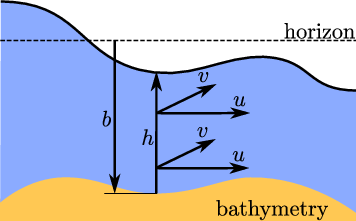
Up to now, the governing equation was derived using the conserved quantities U, the flux function F and the source term S. This section concretizes these terms by presenting two different scenarios: simulations assuming a shallow water, based on the shallow water equations, and compressible gas simulations neglecting the viscosity, based on the Euler equations.
Simulation of water with free surfaces is mainly considered to be a three-dimensional problem. Using depth averaged Navier-Stokes equations (see e.g. [Tor01]), this three-dimensional problem can be reformulated to a two-dimensional problem under special assumptions. Among others, vertical moving fluid is assumed to be negligible. This leads to the so-called shallow water equations (SWE) giving a description of the water by its water surface height h, the two-dimensional velocity components (u,v)T and the bathymetry b.
Several ways of a mathematical representation of these quantities are used such as specifying the water surface relative to the horizon or to the bathymetry. We use the shallow water formulation storing the bathymetry b relative to the steady state of the water and the water surface height h relative to the bathymetry [LeV02,BSA12]. For a sea without waves and tidals, b is positive for terrain and negative for the sea floor.

By using the velocity components as conserved quantities, this is considered not to be a momentum conserving formulation. Thus, instead of storing the velocity components, we store both momentums hu and hv as the conserved quantities. This leads to the tuple of conserved quantities

Using this form based on the conserved quantities and assuming a constant bathymetry without loss of generality, we formulate the flux functions G and H (see Eq. (1.4)):

For the flux computations (see Section 2.10), we need the eigenvalues of the Jacobian  . We
start by substituting all v with
. We
start by substituting all v with  and u with
and u with  . This yields
. This yields
 | (1.6) |
By computing the derivative with respect to each of the conserved quantities (h,hu), this yields
 | (1.7) |
Finally, the sorted eigenvalues of the Jacobian of G are given by
 | (1.8) |
which are required for the computation of the maximum time step size.
For compressible flow with a negligible viscosity, the Navier-Stokes equations can be simplified to the so-called Euler equations which belongs to one of the standard models used for fluid simulations. For this work, we consider the two-dimensional Euler equations with the conserved quantities given by U := (ρ,ρu,ρv,E) with ρ being the fluid density, (u,v)T the velocity components and E the energy. The similarities to the shallow water equations are clearly visible by considering the density instead of the height of a water surface. The flux terms G and H are then given with
 | (1.9) |
In this terms, the pressure p depends on the type of gas being simulated. For our simulations, we only consider an isothermal gas with


 | (1.10) |